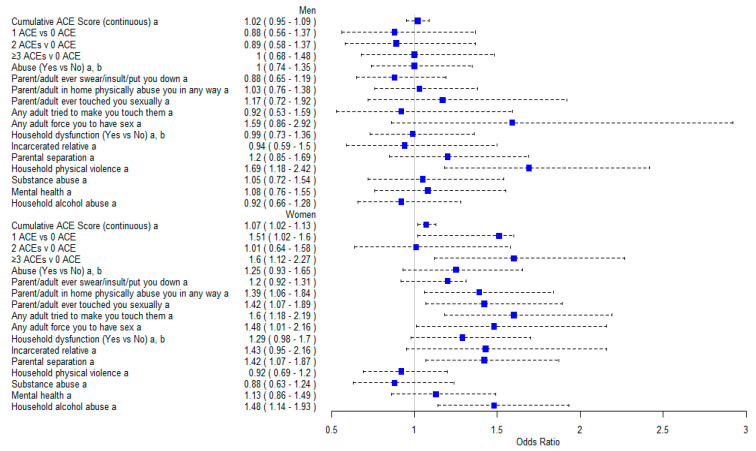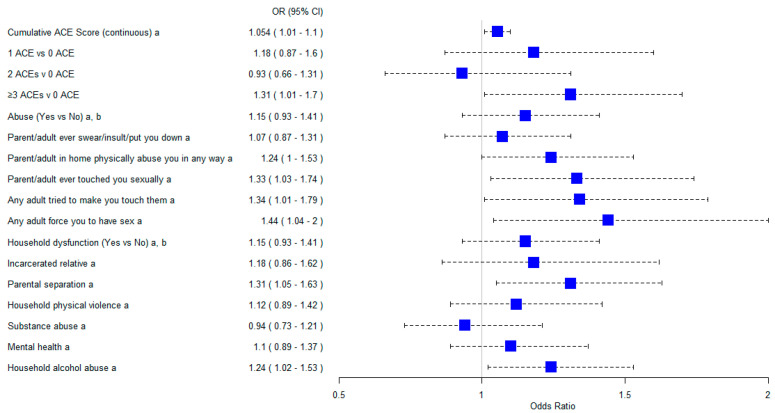童年不良经历对美国成年人哮喘严重程度的影响》(The Impact of Adverse Childhood Experiences on Asthma Severity in US Adults)。
摘要
背景/目的:美国成人哮喘患者的童年不良经历(ACEs)与哮喘严重程度之间的关系还没有得到很好的记录。此外,这种关联是否存在性别差异也未得到充分探讨。我们旨在研究美国成人哮喘患者中哮喘严重程度的发生率,并通过非住院治疗的美国成人哮喘患者的数据来调查 ACE 与哮喘严重程度之间的关联。研究方法:这项横断面研究使用了成人 2019 年和 2020 年行为危险因素监测系统(BRFSS)哮喘回访调查(ACBS)的数据,该调查针对美国 31 个州和波多黎各 18 岁或以上的美国成年人。共有 22934 名哮喘成人参加了 2019 年和 2020 年 ACBS 调查。BRFSS 的 11 个 ACE 变量包括虐待和家庭功能障碍,被用作 ACE 测量值。ACE测量值的总和为累积ACE得分(连续性),并进行分类(0、1个ACE、2个ACE、≥3个ACE)。哮喘严重程度分为间歇性和持续性。加权逻辑回归模型用于评估累积 ACE 分数、分类 ACE 测量值和 11 个 ACE 反应与哮喘严重程度的相关性,并控制混杂因素。通过性别分层探讨了性别差异。研究结果在美国成人哮喘患者中,哮喘持续状态的发病率为 45.3%。间歇性哮喘成人与持续性哮喘成人的 ACE 平均累积得分是(2.43 对 2.70,P 值小于 0.05)。约 22% 的成人哮喘患者没有 ACE,19% 的患者有一个 ACE,14% 的患者有两个 ACE,45% 的患者有三个或更多 ACE。ACE得分每增加一个单位,患持续性哮喘的几率就会增加5.4%(调整后的几率比,aOR = 1.054(95% 置信区间,CI = 1.01-1.10))。与没有经历过 ACE 相比,经历过 ≥ 3 次 ACE 的人患持续性哮喘的几率增加 31%(aOR = 1.31,95% CI = 1.01-1.70)。与持续性哮喘明显相关的 ACE 项目包括:父母/成人曾对您进行性接触(aOR = 1.33,95% CI = 1.03-1.74)、成人试图让您接触他们(aOR = 1.34,95% CI = 1.任何成年人强迫您发生性行为(aOR = 1.44,95% CI = 1.04-1.20)、父母分居/离婚(aOR = 1.31,95% CI = 1.05-1.63)和家庭酗酒(aOR = 1.24,95% CI = 1.01-1.53)。在女性中,经历一次ACE和≥三次ACE(与未经历ACE相比)分别与哮喘持续几率增加51%和60%有关(aOR = 1.51,95% CI = 1.02-2.23;aOR = 1.60,95% CI = 1.12-2.27)。在男性中,没有观察到 ACE 与哮喘严重程度之间有明显的关联;但是,经历家庭身体暴力(与无家庭身体暴力相比)与男性哮喘持续存在有关(aOR = 1.69,95% CI = 1.18-2.42)。结论:在这项针对美国成人哮喘患者的横断面研究中,暴露于 ACE 与总体和女性患哮喘的几率较高有关。这些发现凸显了减少 ACE 的预防策略和早期干预措施的重要性,有可能减轻哮喘在成年后的严重程度。


Background/objectives: The association between adverse childhood experiences (ACEs) and asthma severity among United States (US) adults with asthma has not been well documented. In addition, whether gender differences exist in this association has been underexplored. We aimed to examine the prevalence of asthma severity in the US adult population with asthma and investigate the association between ACEs and asthma severity by using data from non-institutionalized US adults with asthma. Methods: This cross-sectional study used data from the Adult 2019 and 2020 Behavioral Risk Factor Surveillance System (BRFSS) Asthma Call-Back Survey (ACBS), a survey of US adults aged 18 years or older in 31 US states and Puerto Rico. A total of 22934 adults with asthma participated in 2019 and 2020 ACBS. The 11 BRFSS ACE variables encompassing abuse and household dysfunction were used as ACE measures. ACE measures were summed up as cumulative ACE scores (continuous) and categorized (zero, one ACE, two ACEs, ≥ three ACEs). Asthma severity was categorized as intermittent or persistent. Weighted logistic regression models were used to assess associations of the cumulative ACE score, categorical ACE measures, and the 11 individual ACE responses with asthma severity controlling confounders. Gender differences were explored by stratifying by gender. Results: The prevalence of persistent asthma among US adults with asthma was 45.3%. The mean cumulative ACE score in adults with intermittent vs. persistent asthma was (2.43 vs. 2.70, p-value < 0.05). About 22% of adults with asthma had no ACEs, 19% had one ACE, 14% had two ACEs, and 45% had three or more ACEs. A one-unit increase in ACEs score was associated with a 5.4% increase in the odds of persistent asthma (adjusted odds ratio, aOR = 1.054 (95% confidence interval, CI = 1.01-1.10). Experiencing ≥ three ACEs compared to no ACEs was associated with 31% increased odds of persistent asthma (aOR = 1.31, 95% CI = 1.01-1.70). Individual ACE items significantly associated with persistent asthma include parent/adult ever touched you sexually (aOR = 1.33, 95% CI = 1.03-1.74), adult tried to make you touch them (aOR = 1.34, 95% CI = 1.01-1.79), any adult forced you to have sex (aOR = 1.44, 95% CI = 1.04-1.20), parental separation/divorce (aOR = 1.31, 95% CI = 1.05-1.63), and household alcohol abuse (aOR = 1.24, 95% CI = 1.01-1.53). In women, experiencing one ACE and ≥ three ACEs (compared to no ACEs) was associated with 51% and 60% increased odds of persistent asthma, respectively (aOR = 1.51, 95% CI = 1.02-2.23; aOR = 1.60, 95% CI = 1.12-2.27). No significant association was observed between ACEs and asthma severity in men; however, experiencing household physical violence (compared to no household physical violence) was associated with persistent asthma in men (aOR = 1.69, 95% CI = 1.18-2.42). Conclusions: In this cross-sectional study of US adults with asthma, exposure to ACEs was associated with higher odds of asthma overall and in women. These findings highlight the importance of preventive strategies and early interventions to reduce ACEs, potentially mitigating asthma's severity in adulthood.

 求助内容:
求助内容: 应助结果提醒方式:
应助结果提醒方式:


